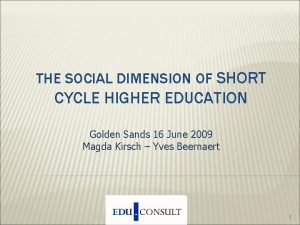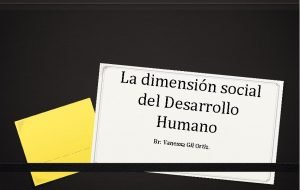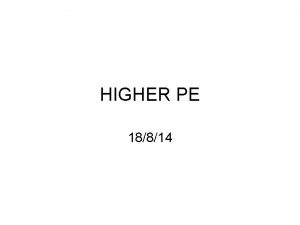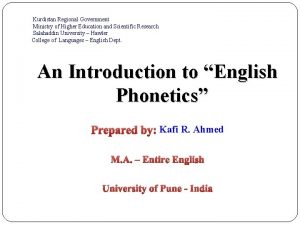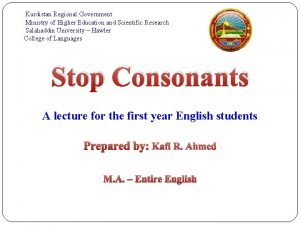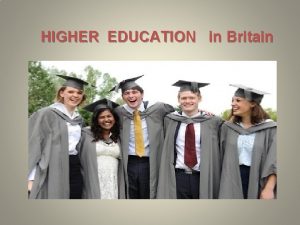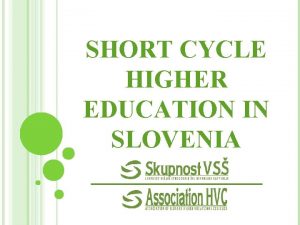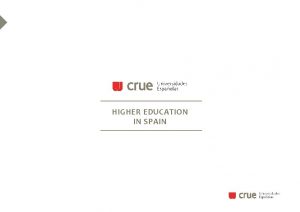THE SOCIAL DIMENSION OF SHORT CYCLE HIGHER EDUCATION
















- Slides: 16

THE SOCIAL DIMENSION OF SHORT CYCLE HIGHER EDUCATION Golden Sands 16 June 2009 Magda Kirsch – Yves Beernaert 1

TERMINOLOGY Short Cycle Higher Education in Europe EU = European Union 27 countries Bologna process involves 46 countries ECTS = European Credit Transfer System Diploma Supplement Erasmus = mobility programme for university students (part of LLL programme) Learning outcomes: what a student is able to do Tuning EC-project on the learning outcomes of 9 subject areas at Bachelor’s and Master’s level ENQA = European Network for QA ENQAR= European Network for QA Register 2

RATIONALE Access to HE in many countries still a problem for certain socio-economic groups Gap by social class significant but narrowing slightly – Participation rates of young first entrants from lower socio-economic groups still far too low Large gap by social-economic background (SES) at the end of SO Many more drop-outs Many more students from VET , often not ready to attend HE For adult learners without SE diploma difficult to pick Short Cycle Higher Education in Europe up at level 6 3

SOCIAL BACKGROUND OF STUDENTS It is generally believed that SCHE tends to attract more students from socio-economic groups that would otherwise not participate in HE. v Overall majority in the UK are part-time students In many European countries (especially those without entrance exams) high drop-out rate in the first year of HE v Linked to socio-economic background Educational Personal career (general education vs. VET) characteristics Short Cycle Higher Education in Europe 4

SOME EXAMPLES OF THE GAP v Flanders : Diversity charter signed by each H. Ed. Institution + institutional policy v Access to HE Less than 20% of boys of migrant origin (usually low SES) enter HE - Less than 25% of girls of migrant - Native youngsters respect. 57% & 71%) Source : N. Duquet e. a. , Wit krijt schrijft beter v Success rate - 20% of migrant youngsters successful vs. 56% natives - 35% of migrant youngsters fail vs. 22% natives - 45% drop-out with migrant younsters vs. 22% natives Source: M. Lacante e. a. , Short Allochtonen ininhet Cycle Higher Education Europe. HO - 5

SOME EXAMPLES OF THE GAP v UK: England: Aim Higher Programme Attainment – large gap at GCSE by social class – 35% gap between highest & lowest quartiles Aspirations – 60% 11 -16 yr olds in non-work households want to go to HE vs 74% in where 2 parents work Information, Advice and Guidance - 70% of HE students wanted more & better advice pre HE Progression routes - 89% 2 A-levels+ go to HE vs 40% Level 3 vocational qualifications Above factors interact together Source: Dr. Graeme Atherton, Widening Access to Higher Education and 2012: How do we measure it? Short Cycle Higher Education in Europe 6

SOME EXAMPLES OF THE GAP v The Netherlands: Policy + ECHO Expertise Centre for Diversity in H. Ed Male youngsters of migrant origin are 3 times more likely to drop-out of HE Identical situation for native youngsters from the same SES and with the same characteristics Individual characteristics Social characteristics of the family Educational characteristics of the family Location of the school Source: Traag and Vander Velden (2007) Short Cycle Higher Education in Europe 7

Short Cycle Higher Education in Europe INSTRUMENTS FOR ENHANCING DIVERSITY Integration of diversity in institutional policy Research and monitoring of policies in H. Ed. Framework for diversity : pedagogy of excellence: UCLA Student counselling / student career counselling Information adapted to target group Tutors, mentors, buddies Academic language support Flexible learning & study pathways 8

BOLOGNA DECLARATION LEUVEN 2009 Social dimension: equitable access and completion The student body within higher education should reflect the diversity of Europe’s populations. We therefore emphasize the social characteristics of higher education and aim to provide equal opportunities to quality education. Access into higher education should be widened by fostering the potential of students from underrepresented groups and by providing adequate conditions for the completion of their studies. . Within national contexts, intermediate qualifications within the first cycle can be a means of widening access to higher education. 9 Short Cycle Higher Education in Europe

HOW CAN SCHE CONTRIBUTE? v By being a bridge between levels 3, 4 and 6 of the EQF v Giving the opportunity to climb the ladder of education slowly but surely v Meeting the needs of the labour market for highly skilled technicians v Giving a new chance to school and HE dropouts v By promoting APEL Short Cycle Higher Education in Europe 10

HOW CAN SCHE CONTRIBUTE? v By enhancing completion rate in HE v By for lowering the threshold generation HE students v first By being closer to the community (different kinds of institutions) v By collaborating with professional bodies and industry Short Cycle Higher Education in Europe 11

RESOLUTION OF THE COUNCIL OF THE EU: ENABLING HE TO MAKE ITS CONTRIBUTION TO THE LISBON STRATEGY (MARCH 2005) 1. adapting, where necessary, … to the changing needs of society … 2. enhancing the attractiveness of HE through high quality facilities, better information, greater diversity in teaching and learning, particularly by means of ICT … 3. widening access to higher education, particularly for people from disadvantaged backgrounds, helping individuals to achieve their potential and enabling a greater variety of paths to higher education, making lifelong learning a reality; 4. encouraging diversity within higher education systems and institutions and also developing centres of Short Cycle Higher Education in Europe 12 excellence…

RESOLUTION OF THE COUNCIL OF THE EU: ENABLING HE TO MAKE ITS CONTRIBUTION TO THE LISBON STRATEGY (MARCH 2005) 5. encouraging HEI to develop sustainable partnerships with the broader community and industry, in order to meet the changing needs of society and the labour market; 6. involving all stakeholders in the preparation and implementation of reforms; considering investment in higher education as an investment in the future of society; 7. examining the level of resources… 8. providing incentives for reform, for instance, by targeting investment to improve the quality of teaching and learning, research, innovation, management and student services. Short Cycle Higher Education in Europe 13

ELEMENTS OF GOOD PRACTICE IN SCHE The development of higher education systems along the concept of the ladder of learning coupled to a network of learning Several countries clearly want to promote explicitly or implicitly a coherent ladder of progressive learning (Ireland, UK, Sweden, France etc. ). Moreover a number of countries (e. g. Norway) have coupled this ladder of learning to a network of learning with possibilities for students to move across different parts of the higher education systems. Short Cycle Higher Education in Europe 14

ELEMENTS OF GOOD PRACTICE IN SCHE Close links with companies ( teachers, curriculum design and updating) Involvement of companies in the design and the implementation of the curriculum, Work-based approach (alternating study and work) of some of the new learning pathways. New foundation degrees in the UK are developing well as employer-focused higher education qualifications. Short Cycle Higher Education in Europe 15

Short Cycle Higher Education in Europe http: //eurlex. europa. eu/Notice. do? mode=dbl&lang=en&ihmlang=en&lng 1=en, nl&ln g 2=cs, da, de, el, en, es, et, fi, fr, hu, it, lv, nl, pt, sk, sl, sv, &val=417635: cs&pag e= THANK YOU FOR YOUR ATTENTION! 16
 Tall+short h
Tall+short h Short cycle higher education
Short cycle higher education Dimensiones de la expresión oral
Dimensiones de la expresión oral Social thinking social influence social relations
Social thinking social influence social relations Social thinking social influence social relations
Social thinking social influence social relations Cycle of analysis higher pe
Cycle of analysis higher pe Cycle of analysis higher pe
Cycle of analysis higher pe Higher education web analytics
Higher education web analytics Capacity building in the field of higher education
Capacity building in the field of higher education Importance of faculty in higher education
Importance of faculty in higher education Rhode island board of governors for higher education
Rhode island board of governors for higher education Ppc for higher education
Ppc for higher education Ministry of higher education afghanistan
Ministry of higher education afghanistan Massachusetts higher education consortium
Massachusetts higher education consortium Ministry of higher education krg
Ministry of higher education krg Krg ministry of higher education
Krg ministry of higher education Kurdistan
Kurdistan

